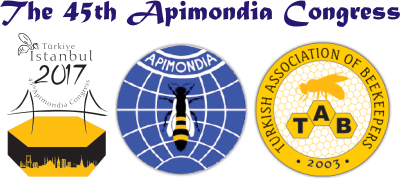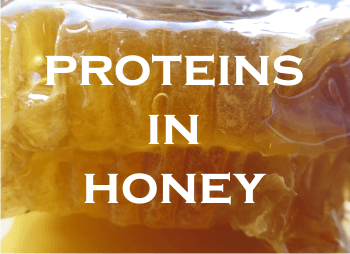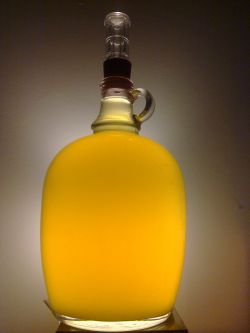Artificial honey or fake honey? What is the difference and why should we care? But then, what is natural honey? The opposite, of course.
Fake honey is honey that has been adulterated. It was real honey in the beginning, and then other substances were added to increase its quantity or change its value: glucose, dextrose, molasses, sugar syrup, flour, corn syrup, starch, or any other similar product, other than floral nectar.
Even artificial honey can be added to real honey. Some say this addition of inverted sugar to natural honey tends to improve its quality and, especially to render it more easily digested.
Artificial honey is the old synonym for invert sugar syrup – a liquid that is produced by chemical methods and has nothing to do with honey bees.
However, linguistically, artificial honey is fake honey.
I have to admit that, in my innocence, I have never even considered this possibility. Honey is such a remarkable product, why try to artificially produce something that nature makes so well?
It seems that I always forget the thing that makes the world move: money.
The list of food that are actually not food is very long: eggs, cheese, cream, chocolate flakes, caramel, whipped cream, peanut butter, ice cream, butter, potatoes, chocolate milk, orange juice, maple syrup, bacon and so on. I wonder if it isn’t better (at least for our mental health) to just ignore them all. (I’m sure the producers are counting on this!)
Anyway, the honey that you have thought it is used on every bakery product – is not real honey. The honey you read about on your cereal bag – is not real honey. And so on. You can only have real, natural honey in a jar with a label that says “raw honey”. Other than that… no.
What is MeliBio? Fake honey or future honey?
Why invent artificial honey?
Because it is cheaper!
Artificial honey was invented to be used in bakeries as a sweet spread for bread and other types of sweet things like Printen (honey cookies covered with almonds), gingerbread and all the other baked products. And to be used in restaurants as a sweetener for mixed drinks, to brush meat to get crusty roasts, to make whatever has to be sweet. And no, they never use real honey.
Composition of artificial honey
Artificial honey is mostly made from inverted sucrose from beet or cane sugar. It is produced with or without starch sugar or starch syrup. It is adjusted in appearance, odor and flavor to imitate true honey.
Depending on the production method, such creams contain non sugar constituents, minerals, sucrose and hydroxymethyl furfural.
Artificial honey contains:
– invert sugar – which is glucose and fructose (≥50%),
– sucrose (≤38.5%)
– water (≤22%),
– ash (≤0.5%)
– saccharified starch products (≤38.5%) – when necessary,
pH of the mixture should be ≥2.5.
Aroma carrier is primarily phenylacetic acid ethyl ester and, occasionally, diacetyl, etc.
Hydroxymethyl furfural content is 0.08−0.14%.
Color: depending on request, this liquid is often colored with certified food colors. Artificial or not.
How is artificial honey produced:
According to Food Chemistry, by Professor Dr.-Ing. H.-D. Belitz and Professor Dr.-Ing. W. Grosch, artificial honey is produced following these steps:
Sucrose (75% solution) is cleaved into glucose and fructose by acidic hydrolysis using (at choice) hydrochloric, sulfuric, phosphoric, carbonic, formic, lactic, tartaric or citric acid or, less frequently, enzymatically using invertase.
The acid used for inversion is then neutralized with sodium carbonate or bicarbonate, calcium carbonate etc.
The inverted sugar is then aromatized, occasionally with strongly flavored natural honey.
To facilitate crystallization, it is seeded with an invert sugar mixture that has already solidified, then packaged with
automated machines.
During inversion, an oligosaccharide (a “reversion dextrin”) is also formed, mostly from fructose. Over inversion,
by prolonged heating, results in dark coloring of the product and in some bitter flavor. Moreover, glucose and fructose degradation forms a noticeable level of hydroxymethyl furfural – this could be used for identification of artificial honey.
Liquid artificial honey is made from inverted and neutralized sucrose syrup. To prevent crystallization, up to 20% of a mildly degraded, dextrin-enriched starch syrup is added (the amount added is proportional to the end-product
weight).”
Fake honey! Do you really know what you’re eating?
What is the difference between pure honey and raw honey?
You can make artificial honey yourself!
Prof. Herzfeld gives a practical method for preparing this form of sugar.
Take 1 kilogramme (2.2 pounds) of high-quality refined sugar in a clean enamel ware vessel, and add 300 cubic centimeters (10 fluid ounces) of water and 1.1 grammes (17 grains) tartaric acid (like this one: Generic 6360B Tartaric Acid, 1 lb.).
Heat at 110°C over an open fire, stirring all the while, and keep at this heat until the liquid takes on a fine golden yellow color. It may take about 45 to 60 minutes.
Fake honey (aka adulterated honey) can be easily made with this method. Simply add the above resulted liquid to a jar of honey in order to obtain 2 jars of honey. 🙁
Organic honey vs regular honey
Should we avoid food made with artificial honey?
It’s sugar, nothing more. It will not harm you more than regular table sugar, or HFCS. If the food producers considered that this sugary liquid tastes better and offers a different touch to the food than simple sugar, and tried to copy some of honey’s properties, you should not be concerned that it is bad for your health. It acts as simple sugar.
More and more artificial?
It is a tendency, indeed. Because we are smart and our technology allows us to be even smarter. We have created artificial intelligence, and this will lead us to live an even more artificial life. I only hope it will not be on an artificial Earth.
The Chinese have invented artificial eggs. I believe honey was a lot easier to produce. And in case you didn’t know about fake eggs, yes, they are real. Fake egg’s shell is made of calcium carbonate. Egg yolks and egg whites are made of sodium alginate, alum, gelatin, eatable calcium chloride and then add water and food coloring.
And if we have to compare fake honey to fake eggs, honey is by far healthier.
Fake egg is full of chemicals, the main ingredient, calcium alginate, is a gel. Alum, gelatin etc are only as additives, auxiliary agents. There are national standards on the use of additives; the amount of them is clearly defined. In the artificial eggs they have become the major components; they are not beneficial to the human body. Artificial eggs have little or no nutritional value compared with real eggs.
There are also artificial eggs made from PLANTS, on sale in the US since 2013, backed by Paypal billionaire Peter Thiel and Bill Gates! It can replace eggs in everything from cakes to mayonnaise – without a chicken ever coming close to the production process! (as reported in Dailymail.co.uk)
Just pay attention to the brand: Hampton Creek’s products: mayonnaise (Beyond Eggs) and cookies. As they say: “It’s eggstraordinary: The powder is a special blend of plants, including peas and beans.” Way much healthier than the Chinese chemical eggs.
References:
https://www.scientificamerican.com/article/artificial-honey/
chinahush.com
featured picture credit three-shots via pixabay.com



